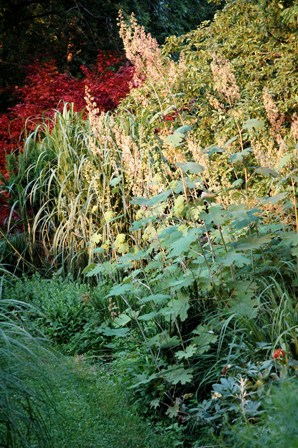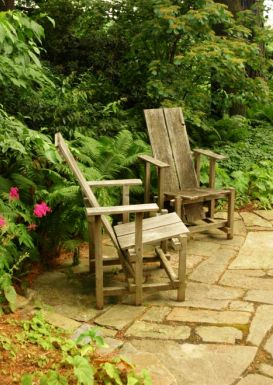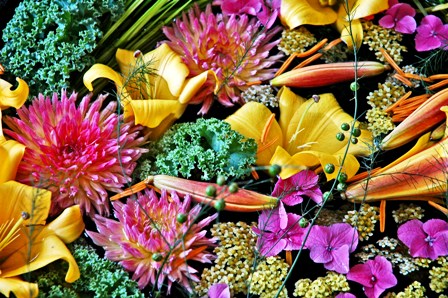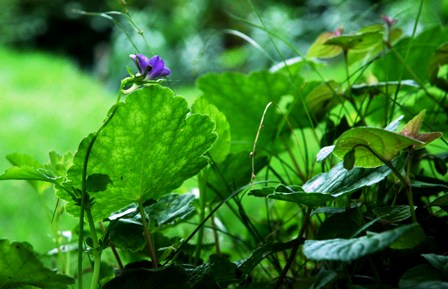In my last Digging Deep post, we began discussing the process of creativity and the possibility of learning to live a more creative life, in and out of the garden.
The subject of this second workshop is to explore Stage One of the creative process: it is Imagining, what I call the sparks of creativity.
To imagine is to see possibilities, to envision realities that don’t yet exist, and to map out secret paths not yet charted. Our imaginations are our own mental playgrounds, where we release our dreams to romp without risk or fear. It is here, in the inner regions of our psyches, that we are free to explore who we truly are and let our thoughts and wishes run wild. It is here that we cook up all our fantasties, our deepest desires, and very often, all the hopes and longings that we never share with another living soul. It is from this wellspring that we draw the inspiration that serves as the spark for our creative fires.
 So how do we tap into our imagination so that we can learn to romp, play and be spontaneous? Observing is the first step: it is simply the act of consciously attending to or making note of something. In the fast paced world we inhabit in the twenty first century, so many of us move through our days as if blindfolded, at an extremely hectic pace. Observing is the polar opposite of that. It means tapping all of our senses to really see, feel, taste, smell and touch the world around us in such a way that we reconnect with our sensuality. We awaken our aesthetic intelligence, our appreciation for beauty, harmony, melody, aroma, and sensation—all of which illuminate our imaginative energies and serve as the palette from which we can draw. Observing the natural world around us is one of the simplest ways to begin to awaken our senses and stimulate our creative fires.
So how do we tap into our imagination so that we can learn to romp, play and be spontaneous? Observing is the first step: it is simply the act of consciously attending to or making note of something. In the fast paced world we inhabit in the twenty first century, so many of us move through our days as if blindfolded, at an extremely hectic pace. Observing is the polar opposite of that. It means tapping all of our senses to really see, feel, taste, smell and touch the world around us in such a way that we reconnect with our sensuality. We awaken our aesthetic intelligence, our appreciation for beauty, harmony, melody, aroma, and sensation—all of which illuminate our imaginative energies and serve as the palette from which we can draw. Observing the natural world around us is one of the simplest ways to begin to awaken our senses and stimulate our creative fires.
Discovering your wishes , the next step in Imagining, is one of the most basic ways to begin unearthing your authentic roots. In order to create anything that has true resonance for you, you must first know what really calls to you. Otherwise you are just casting about, dabbling with this or that– a process from which you may or may not create a solution. Certainly whatever end you come to might work just fine, but what was truly gained in the process? Did you learn anything about yourself? Have you grown as a result?
In the garden, there are literally hundreds of options that you can incorporate. It can be quite overwhelming. The assignment for this week can help you discover what calls to you as well as facilitating you in taking ownership of your authentic, unique self.
To Try:
Get your hands on any gardening, home and lifestyle magazines. Then set aside a designated amount of time and begin to browse through and earmark anything that grabs your fancy that relates to the garden. It can be flowers, an actual garden bed, a type of tree, a structure such as a fountain or pergola, or just the overall look and feeling of a garden. Tear out anything that calls to you. Don’t censor yourself—-there are no rules with this activity. Just have fun. Pick and choose and rip out as you feel inclined. Take breaks if you want. You don’t need to cram a whole garden’s worth of inspirations into one afternoon. I also encourage you to pick up a few gardening books that appeal to you. Go through the pages and put Post-its on the ones that you love, even if you don’t know exactly why.
As you peruse and dream, try not to let the ‘how-to’ element sneak in. That is the censor of your mind trying to impose limits. People censor themselves so much, but this exercise is like brainstorming. Don’t worry about what to do with the material or how you’ll translate it into your garden; just like what you like. We’ll deal with pulling it altogether later. For now, simply take pleasure in finding things that speak to you without having to give them structure or meaning, like the beginning of love.
 We go into fear so quickly when we do exercises like this, because we immediately assume we have to have an agenda–a reason or theme behind our likes or dislikes. We become frustrated and think ‘I can’t do this….this is impossible!” The key to unlocking this barrier is to recognize the frustration simply as fear. There is nothing you need to do about it, nothing you need to figure out, no problems to solve right now. Now is truly the fun part–just let go and dream!
We go into fear so quickly when we do exercises like this, because we immediately assume we have to have an agenda–a reason or theme behind our likes or dislikes. We become frustrated and think ‘I can’t do this….this is impossible!” The key to unlocking this barrier is to recognize the frustration simply as fear. There is nothing you need to do about it, nothing you need to figure out, no problems to solve right now. Now is truly the fun part–just let go and dream!
This exercise will help you begin to see your likes and dislikes, thus allowing you to become more intimate with the longings within you. Being honest about your likes and dislikes frees you from the tyranny of other peoples’ opinions, which can often cloud your authentic desires. Keep the pictures that you find safely tucked away somewhere because they’ll be used later in another exercise.
Let’s return for a moment to last week’s assignment. You were asked to write down on a daily basis any creative moments or chunks of time that you experienced and the feelings that accompanied them. Please share your week of creative moments with us: tell us what you experienced and learned about yourself.
***Note: Although I’ve only talked about 2 elements, Observing and Discovering, there are 4 other elements that embody Imagining. They are: Remembering, Exploring, Opening To Possibility and Playing. You can read more about them in my book, Digging Deep: Unearthing Your Creative Roots Through Gardening, available in paperback and Kindle format.
*******************************************
Click here to see all posts in the Digging Deep series
*******************************************


